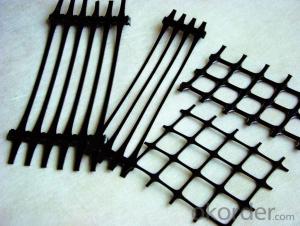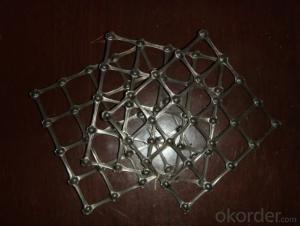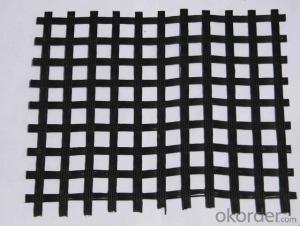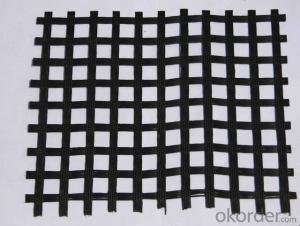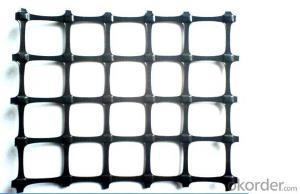Reinforcement Uniaxial PP Geogrid
- Loading Port:
- China Main Port
- Payment Terms:
- TT or LC
- Min Order Qty:
- -
- Supply Capability:
- -
OKorder Service Pledge
OKorder Financial Service
You Might Also Like
1. Product Description:
Double-direction geogrid is made of high molecular polymer through extrusion, forming and punching before longitudinal and lateral stretching. This material has considerable tensile strength in longitudinal and lateral directions. This chain structure can effectively bear and diffuse forces on soil and is applicable to large area permanent load bearing foundation as a reinforce.
2. Product Characteristic:
1. Increase the bearing capacity of the roadbed and foundation and prolong their service life.
2. Prevent road surface and foundation from sinking or flawing, keep clean and beautiful ground surface.
3. Convenient construction saves time and labor, reduce mounting time and decrease maintenance expense.
4. Enhance earth slope and prevent water loss and soil erosion.
5. Decrease underlayer thickness and save manufacturing cost.
3.Specification :
Item | TGSG15-15 | TGSG20-20 | TGSG25-25 | TGSG30-30 | TGSG40-40 |
Longitudinal Tensile Strength,kN/m | 15 | 20 | 25 | 30 | 40 |
Transverse Tensile Strength,kN/m | 15 | 20 | 25 | 30 | 40 |
Longitudinal Yield Elongation,% | 15 | ||||
TransverseYield Elongation,% | 13 | ||||
Longitudinal Yield Strength at 2% Elongation,kN/m | 5 | 7 | 9 | 11 | 14 |
Transverse Yield Strength at 2% Elongation,kN/m | 5 | 7 | 9 | 11 | 14 |
Longitudinal Yield Strength at 5% Elongation,kN/m | 7 | 14 | 17 | 21 | 30 |
Transverse Yield Strength at 5% Elongation,kN/m | 7 | 14 | 17 | 21 | 30 |
Product Length/roll,m | 50 | 40 | |||
Product width ,m | 3.9/3.95/4 | ||||
4. Reference Picture:
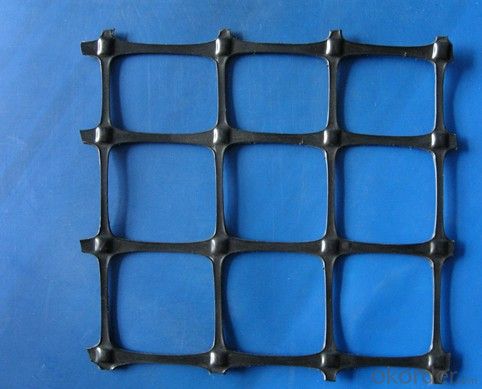
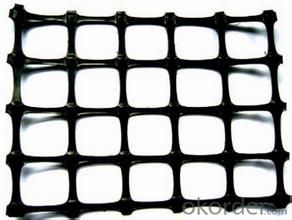
- Q:What is the difference between woven and non-woven geogrids?
- Woven geogrids are made by weaving polyester or polypropylene yarns together, resulting in a strong and flexible grid structure. On the other hand, non-woven geogrids are manufactured by bonding or needle-punching synthetic fibers, creating a random network of fibers. The main difference lies in their structure and manufacturing process, which influences their mechanical properties and application. Woven geogrids tend to have higher tensile strength and are suitable for stabilizing soil in applications such as road construction, while non-woven geogrids are more commonly used for erosion control and filtration purposes.
- Q:What is the recommended geogrid aperture size?
- The recommended geogrid aperture size depends on various factors such as the type of soil and the intended application. It is best to consult with a geotechnical engineer or refer to specific industry standards and guidelines to determine the appropriate geogrid aperture size for a given project.
- Q:How do geogrids help in soil reinforcement?
- Geogrids help in soil reinforcement by providing a strong and stable framework within the soil, preventing its movement and improving its load-bearing capacity. They act as a tensional element, distributing the applied loads and reducing the stress on the soil. This reinforcement helps in preventing soil erosion, improving slope stability, and enhancing the overall performance and longevity of various civil engineering structures.
- Q:Are there any specific maintenance requirements for geogrids?
- Yes, geogrids have specific maintenance requirements. They should be inspected regularly for any signs of damage or deterioration, such as tears, fraying, or disintegration. If any issues are found, appropriate repairs or replacements should be made promptly to ensure the geogrid's effectiveness. Additionally, geogrids should be kept clean and clear of any debris or vegetation that could impact their performance.
- Q:Geogrid width mean?
- Width is the width of Geogrid
- Q:How do geogrids enhance the stability of steep railway cuttings?
- Geogrids enhance the stability of steep railway cuttings by providing reinforcement and increasing the tensile strength of the soil. They are placed within the soil to distribute the stress and prevent sliding or collapse, effectively stabilizing the slope and minimizing erosion.
- Q:How do geogrids improve the performance of soil retaining structures?
- Geogrids improve the performance of soil retaining structures by providing reinforcement and stability to the soil. They enhance the strength and load-bearing capacity of the structure, preventing soil erosion and maintaining the integrity of the retaining wall. Geogrids also distribute the applied forces more evenly, reducing the potential for settlement and improving the overall structural performance and durability.
- Q:How do geogrids improve the performance of asphalt pavements?
- Geogrids improve the performance of asphalt pavements by providing reinforcement and stabilization. They enhance the tensile strength of the pavement, preventing cracking and rutting caused by traffic loads. Additionally, geogrids reduce reflective cracking by distributing the stress from underlying layers, improving the overall structural integrity and lifespan of the pavement.
- Q:Are geogrids suitable for use in ground reinforcement for agricultural facilities?
- Yes, geogrids are suitable for use in ground reinforcement for agricultural facilities. Geogrids provide effective soil stabilization, erosion control, and load-bearing capabilities, making them ideal for reinforcing agricultural areas such as access roads, parking lots, and storage areas. They help distribute the load evenly, prevent soil compaction, and improve overall drainage, resulting in increased durability and longevity of the facilities.
- Q:How do geogrids enhance the stability of steep slopes?
- Geogrids enhance the stability of steep slopes by providing reinforcement and increasing the soil's shear resistance. They act as a barrier, distributing the applied loads and reducing the potential for slope failure. Additionally, geogrids improve slope drainage, preventing the accumulation of excess water that can lead to soil erosion and instability.
1. Manufacturer Overview |
|
|---|---|
| Location | |
| Year Established | |
| Annual Output Value | |
| Main Markets | |
| Company Certifications | |
2. Manufacturer Certificates |
|
|---|---|
| a) Certification Name | |
| Range | |
| Reference | |
| Validity Period | |
3. Manufacturer Capability |
|
|---|---|
| a)Trade Capacity | |
| Nearest Port | |
| Export Percentage | |
| No.of Employees in Trade Department | |
| Language Spoken: | |
| b)Factory Information | |
| Factory Size: | |
| No. of Production Lines | |
| Contract Manufacturing | |
| Product Price Range | |
Send your message to us
Reinforcement Uniaxial PP Geogrid
- Loading Port:
- China Main Port
- Payment Terms:
- TT or LC
- Min Order Qty:
- -
- Supply Capability:
- -
OKorder Service Pledge
OKorder Financial Service
Similar products
New products
Hot products
Hot Searches
Related keywords
